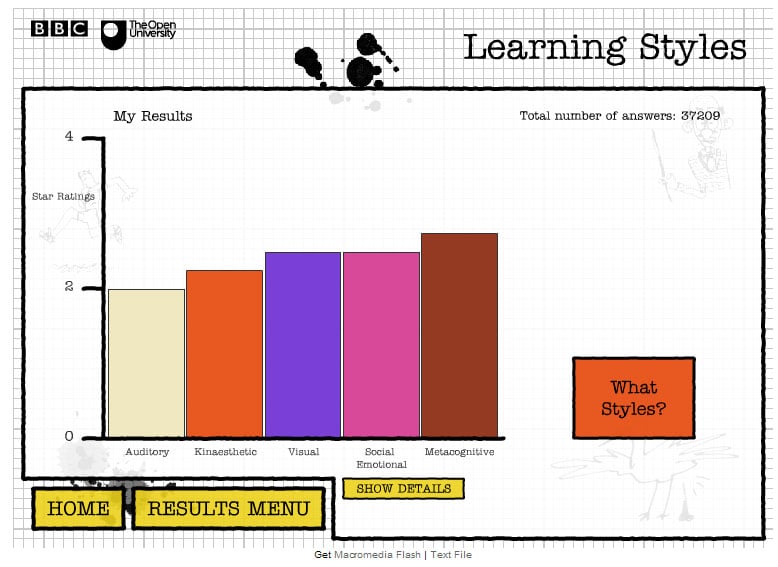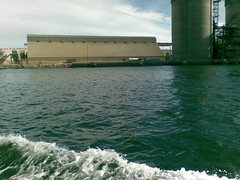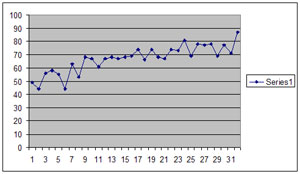 One of the first inquiry units we have on the planner for 2009 is called ''Myself As A Learner". All classes are meant to be exploring this theme in the first fortnight and as part of our professional tuning in we had a couple of staff members run us through a "Learning Preferences" survey which we shared informally. This one came from the John Joseph book ''Your Amazing Brain" which charted preferences on a four way axis that listed the following - Dynamic Learner, Innovative Learner, Procedural Learner and Analytic Learner. I remember doing a similar exercise quite a few years ago at a Julia Atkin workshop - it would be interesting to see how that diagram stacks up against my latest version. Anyway, the teacher running the session pointed us towards some more of these surveys available online.
One of the first inquiry units we have on the planner for 2009 is called ''Myself As A Learner". All classes are meant to be exploring this theme in the first fortnight and as part of our professional tuning in we had a couple of staff members run us through a "Learning Preferences" survey which we shared informally. This one came from the John Joseph book ''Your Amazing Brain" which charted preferences on a four way axis that listed the following - Dynamic Learner, Innovative Learner, Procedural Learner and Analytic Learner. I remember doing a similar exercise quite a few years ago at a Julia Atkin workshop - it would be interesting to see how that diagram stacks up against my latest version. Anyway, the teacher running the session pointed us towards some more of these surveys available online.
It shows how much this concept of "Learning Styles" is unconsiously accepted as gospel by teachers when my learning team colleagues decided that getting students to do some of these online surveys and analyse themselves as learners would be a great idea. So, today I started to look at some of the links and to bookmark a number of them when I found my own delicious bookmark to Professor Dan Willingham's video "Learning Styles Don't Exist". This was one of those I'll-get-back-to-it-when-I-have-time bookmarks so I watched it through and pondered its perspective with what I was planning to do with my new batch of students. Now the video is very thought provoking (and I know it had been discussed at length by many of the edublogosphere's deepest thinkers about six months ago) but the good thing about the internet is I don't have to only listen / view /read / experience to just one perspective.
 I found Chris Craft's post which led me to Matthew Tabor's thought provoking post which critiqued another perspective which was well worth the read. This gave me the chance to read some varying educators' opinions going beyond the "you must cater for learning styles in your classroom" mantra that I see blindly accepted in many classrooms. (Mine included for much of my career but truth be known I think that I tended to operate on the common sense approach rather than formally set up learning approaches catering for a particular learning style.) Students give varying abilities and skill levels into their classroom and we all have activities we prefer over others in terms of learning but to state that a particular learning style is the best way any one student can learn does not gel with what I've seen in my twenty plus years in the classroom. I recall a big push on learning style analysis a few years ago back when my then school was part of the Blackwood Hills Middle Schooling Cluster. We were given a number of paper questionnaires and surveys in order to identify our middle school students' learning styles with the hint that we would use this information to customise a relevant curriculum for young adolescents. What I tended to find was that these surveys were informative for the individual in recognising their learning preferences in both formal and informal circumstances but not once did I cluster the learners of one style into one group and design learning activities and curriculum around that identified style. I have a feeling that back in 2000/01, that was what the leadership driving the Cluster were after. Plus my thoughts at the time were along the lines of if we spend all our time tailoring teaching and learning to kids' strengths, then how do they develop competency in their areas of weakness?
I found Chris Craft's post which led me to Matthew Tabor's thought provoking post which critiqued another perspective which was well worth the read. This gave me the chance to read some varying educators' opinions going beyond the "you must cater for learning styles in your classroom" mantra that I see blindly accepted in many classrooms. (Mine included for much of my career but truth be known I think that I tended to operate on the common sense approach rather than formally set up learning approaches catering for a particular learning style.) Students give varying abilities and skill levels into their classroom and we all have activities we prefer over others in terms of learning but to state that a particular learning style is the best way any one student can learn does not gel with what I've seen in my twenty plus years in the classroom. I recall a big push on learning style analysis a few years ago back when my then school was part of the Blackwood Hills Middle Schooling Cluster. We were given a number of paper questionnaires and surveys in order to identify our middle school students' learning styles with the hint that we would use this information to customise a relevant curriculum for young adolescents. What I tended to find was that these surveys were informative for the individual in recognising their learning preferences in both formal and informal circumstances but not once did I cluster the learners of one style into one group and design learning activities and curriculum around that identified style. I have a feeling that back in 2000/01, that was what the leadership driving the Cluster were after. Plus my thoughts at the time were along the lines of if we spend all our time tailoring teaching and learning to kids' strengths, then how do they develop competency in their areas of weakness?
I know it paints a picture of a sheep like teaching force but generally we tend to accept methodologies and approaches without too much question as long as we hear the phrase "the research says." Why else would consultants who merely collate and present the pockets of thought and research become known as "brain experts" or "learning styles gurus"? And then there is the disconnect as described to me by a local education researcher between a teacher's stated beliefs about education and their actual classroom practice. Which is exactly why it is important for people like Dan Willingham to challenge our automatic mindset - even if we disagree, it sends readers searching for what they actually believe happens in the process of learning.
 So back to the unit. My tandem and co-planning teaching partners and I are going to strategically use a number of these online measurement tools with our students. The goal is have them take a reasonable sample, collect the results via screenshots and look through them for an overall picture of their learning preferences (note the careful choice of terminology) in a bid to help them gain more insight into their own perception of "Myself As A Learner." The accumulated results should also give me some insight into the group as a whole and help the students to appreciate each other's differences and contributions as we start build the 2009 LA20 learning community.
So back to the unit. My tandem and co-planning teaching partners and I are going to strategically use a number of these online measurement tools with our students. The goal is have them take a reasonable sample, collect the results via screenshots and look through them for an overall picture of their learning preferences (note the careful choice of terminology) in a bid to help them gain more insight into their own perception of "Myself As A Learner." The accumulated results should also give me some insight into the group as a whole and help the students to appreciate each other's differences and contributions as we start build the 2009 LA20 learning community.


 Maths teacher,
Maths teacher,  On Friday I wearily returned from our double class camp, suffering a bit of dehydration and sunburn (I was drinking water and had sunscreened myself but a few urgent issues took precedent on the Friday morning so my own continuing needs took a back seat to student welfare at that time) but very satisfied at how the three days away had turned out. In general, the students had a great time earning praise from our outdoor education instructors for their involvement, their willingness to try new things and their support of each other. One instructor even said that our students were more like country kids - a compliment in her eyes as country kids are generally less concerned with image, more likely to be willing to try outdoor challenges and make their own fun. I thought the campsite facilities were magnificent - there were so many great options for the kids from the Tarzan swing to the flying fox (described as "the thing that moves" by one of my class members) to the trampolines to the gym with its sports equipment, pooltables and air hockey table. If you are a South Australian teacher looking for camp options, I would highly recommend
On Friday I wearily returned from our double class camp, suffering a bit of dehydration and sunburn (I was drinking water and had sunscreened myself but a few urgent issues took precedent on the Friday morning so my own continuing needs took a back seat to student welfare at that time) but very satisfied at how the three days away had turned out. In general, the students had a great time earning praise from our outdoor education instructors for their involvement, their willingness to try new things and their support of each other. One instructor even said that our students were more like country kids - a compliment in her eyes as country kids are generally less concerned with image, more likely to be willing to try outdoor challenges and make their own fun. I thought the campsite facilities were magnificent - there were so many great options for the kids from the Tarzan swing to the flying fox (described as "the thing that moves" by one of my class members) to the trampolines to the gym with its sports equipment, pooltables and air hockey table. If you are a South Australian teacher looking for camp options, I would highly recommend 




